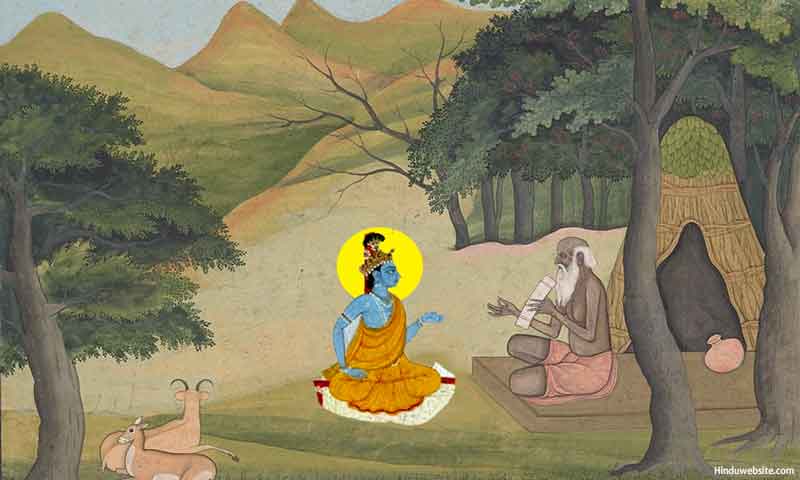
Krishna in the Upanishads

Please do not look for complete answers or information in these. They are fragments of thoughts which deal with only certain aspects of the chosen subject
Krishna in the Upanishads. There is a section (3.17) in the Chandogya Upanishad, which states that Ghora Angirasa taught the sacrificial nature of human life to Krishna, the son of Devaki, whereby he became free from all desires.
Angiras or Angirasa was a mind born son of Brahma and an associate or friend of Atharvan. Both are credited with the authorship of the Atharvaveda. In some lists he is also reckoned as one of the seven seers (saptarishis).
However, the Angirasa who is mentioned in the Upanishad was not the same since the Atharvaveda Veda was composed prior to the Mahabharata war in a previous epoch. He was probably a descendent of the seer or a teacher with the same name or family lineage.
The name may be even a symbolic reference to Agni himself since Agni is said to be the progenitor of a group of celestial beings known as Angiris who act the guardians of fire sacrifices. Who can be a better teacher of fire sacrifice than Agni himself?
Angirasa taught Krishna that life was a sacrifice because it was not meant to be lived for oneself but for the sake of God to perform his duties. In that sacrifice one became both the sacrificer and the sacrificed. We get a brief idea of the nature of his teaching in the previous section (3.16) in which the daily sacrifices were compared to the phases in human life.
If a day equals one lifespan of a human being, the morning becomes comparable to childhood, the afternoon to adulthood, evening to old age and night to death. Accordingly the Upanishad compares the morning prayers to the first 24 years, the midday prayers to the next 40 years, and the evening prayers to the next forty years.
The next section in the Upanishad affirms that not only daily prayers but also actions such as eating, drinking, laughing, sexual intercourse, austerity, charity, etc., also constitute offerings in the sacrifice of life. This was the knowledge which Angirasa conveyed to Krishna and suggested to him that at the time of death he should take refuge in three thoughts, that he was imperishable, unchangeable, the essence of breath.
Life is indeed a sacrifice, especially when you do not live for yourself. In that sacrifice everything that you do and own becomes a potential offering. You can either enjoy the rewards of that sacrifice and incur karma or you can make that offering to God and escape from the cycle of births and deaths.
The central theme of the Bhagavadgita is indeed the same. It is about overcoming desires and performing obligatory duties selflessly with a sacrificial attitude. Chandogya Upanishad is considered one of the oldest Upanishads, if not the oldest. This reference strengthens the argument that the knowledge of the Bhagavadgita is a redaction of the Vedas and Krishna had proper initiation into their study. From this we may also conclude that the Bhagavadgita was based upon his teaching only and not a mythical dialogue. << >>
Suggestions for Further Reading
- What are The Upanishads?
- How old are the Upanishads?
- Exploring the universe the Upanishadic Way
- Which Upanishads One Should Read?
- Who Composed The Upanishads?
- Women in the Upanishads
- Mahavakyas in Your Daily Life
- Sexual Morality in the Upanishads
- Krishna in the Upanishads
- Follow Angirasa as Your Guru as Krishna Did
- How Many Times Do You Reincarnate?
- Are The Upanishads Better Than Modern Psychology?
- Popular Misconceptions About The Upanishads
- Popular Themes of the Upanishads
- The Difference Between Devas And Asuras, Or Between Gods And Demons
- What Brings You Prosperity And Fame?
- Birth and Conception in Hinduism
- The Wisdom of the Upanishads, Main Page
- Essays on The Upanishads
- Upanishads Home Page from Hinduwebsite.com
- Links To Translations of the Upanishads
- List of 108 Upanishads According To The Muktikopanishad
- Introduction to the Upanishads of Hinduism
- A Brief Introduction to the Upanishads
- Essays On Dharma
- Esoteric Mystic Hinduism
- Introduction to Hinduism
- Hindu Way of Life
- Essays On Karma
- Hindu Rites and Rituals
- The Origin of The Sanskrit Language
- Symbolism in Hinduism
- Essays on The Upanishads
- Concepts of Hinduism
- Essays on Atman
- Hindu Festivals
- Spiritual Practice
- Right Living
- Yoga of Sorrow
- Happiness
- Mental Health
- Concepts of Buddhism
- General Essays